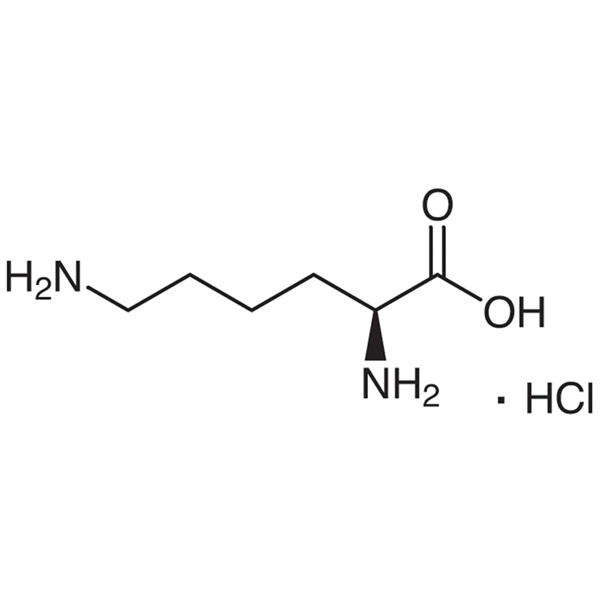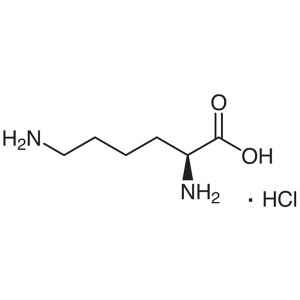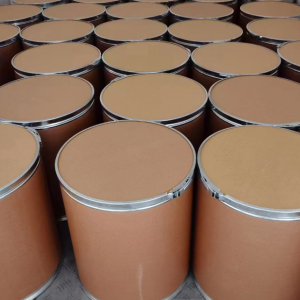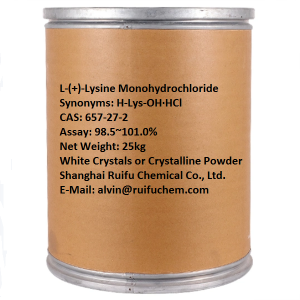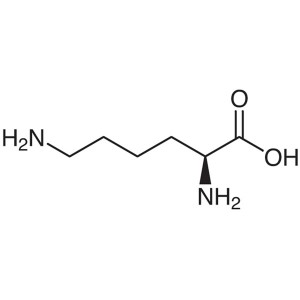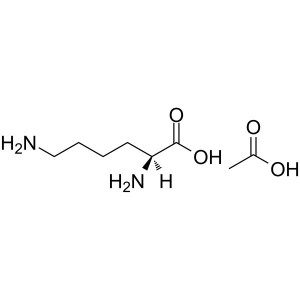L-(+)-Lysine Monohydrochloride CAS 657-27-2 (H-Lys-OH·HCl) Assay 98.5~101.0% Factory High Quality
Shanghai Ruifu Chemical Co., Ltd. is the leading manufacturer and supplier of L-(+)-Lysine Monohydrochloride (H-Lys-OH·HCl) (CAS: 657-27-2) with high quality, production capacity 1000 Tons per year. As one of the largest amino acids suppliers in China, Ruifu Chemical supplys amino acids up to international standards, such as AJI, USP, EP, JP and FCC standards. We can provide COA, worldwide delivery, small and bulk quantities available. If you are interested in L-(+)-Lysine Monohydrochloride, Please contact: alvin@ruifuchem.com
| Chemical Name | L-(+)-Lysine Monohydrochloride |
| Synonyms | H-Lys-OH·HCl; L-Lysine Monohydrochloride; L-Lysine Hydrochloride; L-Lysine HCl; Laevo-Lysine Hydrochloride; Lysine Hydrochloride; Lysine Monohydrochloride; (S)-2,6-Diaminohexanoic Acid Monohydrochloride |
| Stock Status | In Stock, Production Capacity 1000 Tons per Year |
| CAS Number | 657-27-2 |
| Molecular Formula | C6H14N2O2·HCl |
| Molecular Weight | 182.65 |
| Melting Point | 263℃(dec.)(lit.) |
| Density | 1.28 g/cm3 (20℃) |
| Water Solubility | Soluble in Water, Almost Transparency |
| Solubility | Freely Soluble in Water and Formic Acid. Very Slightly Soluble in Ethanol. Practically Insouble in Ether |
| Storage Temp. | Sealed in Dry, Store at Room Temperature |
| COA & MSDS | Available |
| Classification | Amino Acid and Derivatives |
| Brand | Ruifu Chemical |
| Risk Codes | 34 - Causes burns |
| Safety Description | S24/25 - Avoid contact with skin and eyes. |
| UN IDs | UN 1789 8/PG 3 |
| WGK Germany | 2 |
| HS Code | 2922419000 |
| Items | Inspection Standards | Results |
| Appearance | White Crystals or Crystalline Powder | Conforms |
| Identification | Infrared Absorption Spectrum | Conforms |
| Specific Rotation [α]20/D | +20.4° to +21.4°(C=8 in 6N HCl) |
+20.8° |
| State of Solution (Transmittance) | Clear and Colorless ≥98.0% | 98.8% |
| Chloride (Cl) | 19.0 to 19.6% | 19.15% |
| Sulfate (SO4) | ≤0.020% | <0.020% |
| Ammonium (NH4) | ≤0.020% | <0.020% |
| Iron (Fe) | ≤10ppm | <10ppm |
| Heavy Metals (Pb) | ≤10ppm | <10ppm |
| Arsenic (As2O3) | ≤1.0ppm | <1.0ppm |
| Other Amino Acids | ≤0.50% (TLC) | Conforms |
| Loss on Drying | ≤0.40% (at 105℃ for 3 hours) | 0.25% |
| Residue on Ignition (Sulfated) | ≤0.10% | 0.06% |
| Assay | 98.5 to 101.5% (as Dry Basis) | 99.7% |
| Organic Volatile Impurities | Meet the Requirement | Conforms |
| pH Test | 5.0 to 6.0 (1.0g in 10ml of H2O) | 5.2 |
| Residual Solvents | Conforms | Conforms |
| Conclusion | Meets with the Standard of AJI97; USP; JP | |
| Shelf Life | 24 Months From Manufacture Date if Stored Properly | |
| Main Uses | Amino Acids; Food / Feed Additives; Pharmaceutical; Nutritional Enhancer; etc. | |
L-(+)-Lysine Monohydrochloride (CAS: 657-27-2) AJI 97 Test Method
Identification: Compare the infrared absorption spectrum of the sample with that of the standard by potassium bromide disc method.
Specific Rotation [α]20/D: Dried Sample, C=8, 6mol/L HCl
State of Solution (Transmittance): 1.0g in 10ml of H2O spectrophotometer, 430nm, 10nm cell thickness.
Chloride (Cl): Dried Sample, 370mg, B-1
Ammonium (NH4): B-1
Sulfate (SO4): 1.2g, (1), ref: 0.50ml of 0.005mol/L H2SO4
Iron (Fe): 1.5g, (1), ref: 1.5ml of Iron Std. (0.01mg/ml)
Heavy Metals (Pb): 2.0g, (4), ref: 2.0ml of Pb Std. (0.01mg/ml)
Arsenic (As2O3): 2.0g, (1), ref: 2.0ml of As2O3 Std.
Other Amino Acids: Test Sample: 50μg, S-6-a, control: L-Lys HCl 0.25μg
Loss on Drying: at 105℃ for 3 hours.
Assay: Dried sample, 110mg, (3), 2ml of formic acid, 0.1mol/L HCLO4 1ml=9.133mg C6H14N2O2·HCl
pH Test: 1.0g in 10ml of H2O
L-(+)-Lysine Monohydrochloride (CAS: 657-27-2) USP35 Test Method
DEFINITION
Lysine Hydrochloride contains NLT 98.5% and NMT 101.5% of L-Lysine Hydrochloride (C6H14N2O2·HCl), calculated on the dried basis.
IDENTIFICATION
A. INFRARED ABSORPTION <197K>
ASSAY
PROCEDURE
Sample: 90 mg of Lysine Hydrochloride
Blank: Mix 3 mL of formic acid and 50 mL of glacial acetic acid.
Titrimetric system
(See Titrimetry <541>)
Mode: Direct titration
Titrant: 0.1 N perchloric acid VS
Endpoint detection: Potentiometric
Analysis: Dissolve the Sample in 3 mL of formic acid and 50mL of glacial acetic acid. Add 10 mL of mercuric acetate TS, and titrate with the Titrant. Perform the Blank determination.
Calculate the percentage of Lysine Hydrochloride (C6H14N2O2·HCl) in the Sample taken:
Result = {[(VS-VB) xNxF]/W} x100
VS= Titrant volume consumed by the Sample (mL)
VB= Titrant volume consumed by the Blank (mL)
N= actual normality of the Titrant (mEq/mL)
F= equivalency factor, 91.33 mg/mEq
W= Sample weight (mg)
Acceptance criteria: 98.5%~101.5% on the dried basis
OTHER COMPONENTS
CONTENT OF CHLORIDE
Sample: 350 mg of Lysine Hydrochloride
Blank: 140 mL of water
Titrimetric system
(See Titrimetry <541>)
Mode: Direct titration
Titrant: 0.1 N silver nitrate VS
Endpoint detection: Visual
Analysis: Transfer the Sample to a porcelain casserole, and add 140 mL of water and 1 mL of dichlorofluorescein TS. Titrate with the Titrant until the silver chloride flocculates and the mixture acquires a faint pink color. Perform the Blank determination.
Calculate the percentage of chloride (Cl) in the Sample taken:
Result = {[(VS − VB) × N × F]/W} × 100
VS = Titrant volume consumed by the Sample (mL)
VB = Titrant volume consumed by the Blank (mL)
N = actual normality of the Titrant (mEq/mL)
F = equivalency factor, 35.45 mg/mEq
W = Sample weight (mg)
Acceptance criteria: 19.0%~19.6%
IMPURITIES
RESIDUE ON IGNITION <281>: NMT 0.1%
CHLORIDE AND SULFATE, Sulfate <221>
Standard solution: 0.10mL of 0.020 N sulfuric acid
Sample: 0.33g of Lysine Hydrochloride
Acceptance criteria: NMT 0.03%
IRON <241>: NMT 30ppm
Delete the following:
HEAVY METALS, Method I <231>: NMT 15ppm
RELATED COMPOUNDS
Standard solution: 0.05 mg/mL of USP L-Lysine Hydrochloride RS in water. [NOTE-This solution has a concentration equivalent to 0.5% of that of the Sample solution.]
Sample solution: 10mg/mL of Lysine Hydrochloride in water
System suitability solution: 0.4 mg/mL each of USP L-Lysine Hydrochloride RS and USP Arginine Hydrochloride RS
Chromatographic system (See Chromatography <621>, Thin-Layer Chromatography.)
Mode: TLC
Adsorbent: 0.25-mm layer of chromatographic silica gel mixture
Application volume: 5μL
Developing solvent system: Isopropyl alcohol and ammonium hydroxide (7:3)
Spray reagent: 0.2 g of ninhydrin in a mixture of butyl alcohol and 2N acetic acid (95:5)
System suitability
Suitability requirements: The chromatogram of the System suitability solution exhibits two clearly separated spots.
Analysis
Samples: Standard solution, System suitability solution, and Sample solution.
Dry the plate between 100° and 105° until the ammonia completely disappears. Spray with Spray reagent, and heat between 100° and 105° for 15 min. Examine the plate under white light.
Acceptance criteria: Any secondary spot of the Sample solution is not larger or more intense than the principal spot of the Standard solution.
Individual impurities: NMT 0.5%
Total impurities: NMT 2.0%
SPECIFIC TESTS
OPTICAL ROTATION, Specific Rotation <781S>
Sample solution: 80 mg/mL in 6 N hydrochloric acid
Acceptance criteria: +20.4° to +21.4°
LOSSON DRYING <731>: Dry a sample at 105℃ for 3 h: it loses NMT 0.4% of its weight.
ADDITIONAL REQUIREMENTS
PACKAGING AND STORAGE: Preserve in well-closed containers.
USP REFERENCE STANDARDS <11>
USP Arginine Hydrochloride RS
USP L-Lysine Hydrochloride RS
L-(+)-Lysine Monohydrochloride (CAS: 657-27-2) JP17 Test Method
L-Lysine Hydrochloride, when dried, contains not less than 98.5% of L-lysine hydrochloride (C6H14N2O2.HCl).
DescriptionL-Lysine Hydrochloride occurs as a white powder. It has a slight, characteristic taste.
It is freely soluble in water and in formic acid, and practically insoluble in ethanol (95).
It shows crystal polymorphism.
Identification (1) Determine the infrared absorption spectrum of L-Lysine Hydrochloride, previously dried, as directed in the potassium bromide disk method under Infrared Spectrophotometry <2.25>, and compare the spectrum with the Reference Spectrum: both spectra exhibit similar intensities of absorption at the same wave numbers. If any difference appears between the spectra, dissolve L-Lysine Hydrochloride in water, evaporate the water to dryness at 60℃, and repeat the test with the residue.
(2) A solution of L-Lysine Hydrochloride (1 in 10) responds to the Qualitative Tests <1.09> for chloride.
Optical rotation <2.49>[α]20/D: +19.0 - +21.5° (after drying, 2 g, 6 mol/L hydrochloric acid TS, 25 mL, 100 mm)
pH <2.54> Dissolve 1.0 g of L-Lysine Hydrochloride in 10 mL of water: the pH of this solution is between 5.0 and 6.0.
Purity (1) Clarity and color of solution-Dissolve 1.0 g of L-Lysine Hydrochloride in 10 mL of water: the solution is clear and colorless.
(2) Sulfate <1.14>-Perform the test with 0.6 g of L-Lysine Hydrochloride. Prepare the control solution with 0.35 mL of 0.005 mol/L sulfuric acid VS (not more than 0.028%).
(3) Ammonium <1.02>-Perform the test with 0.25 g of L-Lysine Hydrochloride. Prepare the control solution with 5.0 mL of Standard Ammonium Solution (not more than 0.02%).
(4) Heavy metals <1.07>-Proceed with 2.0 g of L-Lysine Hydrochloride according to Method 1, and perform the test. Prepare the control solution with 2.0 mL of Standard Lead Solution (not more than 10 ppm).
(5) Arsenic <1.11>-Prepare the test solution with 1.0 g of L-Lysine Hydrochloride according to Method 1, and perform the test (not more than 2 ppm).
(6) Related substances-Dissolve 0.10 g of L-Lysine Hydrochloride in 25 mL of water, and use this solution as the sample solution. Pipet 1 mL of the sample solution, add water to make exactly 50 mL, pipet 5 mL of this solution, add water to make exactly 20 mL, and use this solution as the standard solution. Perform the test with these solutions as directed under Thin-layer Chromatography <2.03>. Spot 5μL each of the sample solution and standard solution on a plate of silica gel for thin-layer chromatography. Develop the plate with a mixture of 1-propanol and ammonia water (28) (67:33) to a distance of about 10 cm, and dry the plate at 100℃ for 30 minutes. Spray evenly the plate with a solution of ninhydrin in acetone (1 in 50) and heat at 80℃ for 5 minutes: the spots other than the principal spot from the sample solution are not more intense than the spot from the standard solution.
Loss on drying <2.41> Not more than 1.0% (1 g, 105℃, 3 hours).
Residue on ignition <2.44> Not more than 0.1% (1 g).
Assay Weigh accurately about 0.1 g of L-Lysine Hydrochloride, previously dried, dissolve in 2 mL of formic acid, add exactly 15 mL of 0.1 mol/L perchloric acid VS, and heat on a water bath for 30 minutes. After cooling, add 45 mL of acetic acid (100), and titrate <2.50> the excess perchloric acid with 0.1 mol/L sodium acetate VS (potentiometric titration). Perform a blank determination, and make any necessary correction.
Each mL of 0.1 mol/L perchloric acid VS =9.132 mg of C6H14N2O2.HCl
Containers and storage Containers-Tight containers.
Package: Fluorinated Bottle, 25kg/bag, 25kg/Cardboard Drum, or according to customer's requirement.
Storage Condition: Store in sealed containers at cool, dry and ventilated warehouse away from incompatible substances. Protect from light and moisture. Keep away from strong oxidizing agents.
How to Purchase? Please contact Dr. Alvin Huang: sales@ruifuchem.com or alvin@ruifuchem.com
15 Years Experience? We have more than 15 years of experience in the manufacture and export of a wide range of high quality pharmaceutical intermediates or fine chemicals.
Main Markets? Sell to domestic market, North America, Europe, India, Korea, Japanese, Australia, etc.
Advantages? Superior quality, affordable price, professional services and technical support, fast delivery.
Quality Assurance? Strict quality control system. Professional equipment for analysis include NMR, LC-MS, GC, HPLC, ICP-MS, UV, IR, OR, K.F, ROI, LOD, MP, Clarity, Solubility, Microbial limit test, etc.
Samples? Most products provide free samples for quality evaluation, shipping cost should be paid by customers.
Factory Audit? Factory audit welcome. Please make an appointment in advance.
MOQ? No MOQ. Small order is acceptable.
Delivery Time? If within stock, three days delivery guaranteed.
Transportation? By Express (FedEx, DHL), by Air, by Sea.
Documents? After sales service: COA, MOA, ROS, MSDS, etc. can be provided.
Custom Synthesis? Can provide custom synthesis services to best fit your research needs.
Payment Terms? Proforma invoice will be sent first after confirmation of order, enclosed our bank information. Payment by T/T (Telex Transfer), PayPal, Western Union, etc.
L-(+)-Lysine Monohydrochloride (H-Lys-OH·HCl) (CAS: 657-27-2) is widely used as nutritional supplements in food and beverage industries. It can also be used in animal feed as source of L-Lysine. L-Lysine Monohydrochloride can be used in a wide variety of industries including: food production, beverage, pharmaceutical, agriculture/animal feed, and various other industries.
Product Functions & Applications:
1. Lysine HCL is a feed nutrition fortifier, which has the functions of enhancing appetite of livestock and poultry, improving disease resistance, promoting wound healing, improving meat quality, enhancing gastric secretion, and synthesizing brain nerves, germ cells, proteins and hemoglobin essential substances. Generally the amount added in the feed is 0.1-0.2%.
2. Lysine HCL is an essential amino acid in the human body, which can enhance hematopoietic function, enhance gastric juice secretion, increase protein utilization, increase disease resistance, maintain metabolic balance, and help promote the development of children's chemicalbook physical and mental development. China stipulates that flour, biscuits and bread that can be used for processing noodles are used in an amount of 1 to 2g/kg; 0.3 to 0.8g/kg in drinking liquid.
3. Lysine HCL is one of the most important amino acids, and the amino acid industry has now become an industry of considerable scale and importance. Lysine is mainly used in food, medicine and feed.
Function:
1. Food grade: nutritional enhancer, used for seasoning in mayonnaise, milk, instant noodles food
2. Medcine grade: preparation for compound amino acid transfusion, improving efficiency of drugs
3. Feed grade: make poultry nutrition balance, improve meat quality and productivity
L-(+)-Lysine Monohydrochloride is mainly produced by fermentation using strains of corynebacteria, especially Corynebacterium glutamicum, which comprises a multi-step process including fermentation, cell separation by centrifugation or ultrafiltration, product separation and purification, evaporation and drying. Because of L-Lysine great importance, efforts are constantly being made in order to improve the fermentation processes, comprising strain and process development as well as media optimization and downstream processing are used for the production of L-lysine and other L-amino acids, operation in mixing tank or air lift fermenters.

